Marla Spivack
World Bank
Insight Note
The rapid expansion that has brought nearly every child, girl and boy, into formal schooling is a remarkable development achievement. Despite this dramatic success in expansion, far too many children spend years in school without acquiring adequate basic skills.
Governments, donors, and international organisations are increasingly acknowledging this learning crisis, and working to address it. Many are adopting an emphasis on the challenges faced by girls. The focus on quality education for girls provides an opportunity to move the education agenda to the next level: achievement of the global Sustainable Development Goal (SDG) of providing every child with a quality education that achieves, at a minimum, functional literacy and numeracy.
Four insights from completed and ongoing work from the Research on Improving Systems of Education (RISE) Programme can inform this effort:
There are many benefits to more years of schooling for girls, and even greater benefits when those years produce more learning.
A large body of research documents the benefits of women’s schooling for life outcomes.1 The typical analysis shows connections between schooling and outcomes, for instance, comparing the mortality of children born to women with no schooling to women who complete primary school. This approach has found a positive association between education and a wide range of positive life outcomes for women and their families: women’s empowerment, lower age of first pregnancy, fertility rate, malnutrition, child health and survival, and others.
Due to data limitations, past approaches did not distinguish between women who completed primary schooling, but did not gain literacy, and women who both completed school and achieved literacy skills. This made it impossible to estimate the improvements in life outcomes that resulted from learning.
In a forthcoming paper, Kaffenberger et al.2 show that estimating the gains from education this way underestimates the benefits of education by failing to account for the higher returns to schooling that produces learning. Recent rounds of the Demographic and Health Survey (DHS) and Financial Inclusion Insights (FII) data contain a measure of women’s ability to read. Using that data they can estimate the association (not causation) of both women’s schooling and the attainment of literacy on life outcomes.
They find that across four different indicators (child mortality, fertility, women’s empowerment, and financial practices) the “impact of basic education”–primary schooling plus gaining literacy–is about three times larger than typical estimates of the “impact of primary schooling”. As seen in Figure 1, based on the results of the paper, the gains from women’s education are much bigger than the typical cross-tabulation or regression methods that use schooling alone and do not control for learning or correct for measurement error suggest. For these outcomes, achieving literacy, just one aspect of learning, accounts for one-third to one-half of education’s impact on average.
Getting girls into schooling and improving learning will deliver the benefits policymakers seek from the focus on girl’s education, much more so than just expansion of schooling alone.
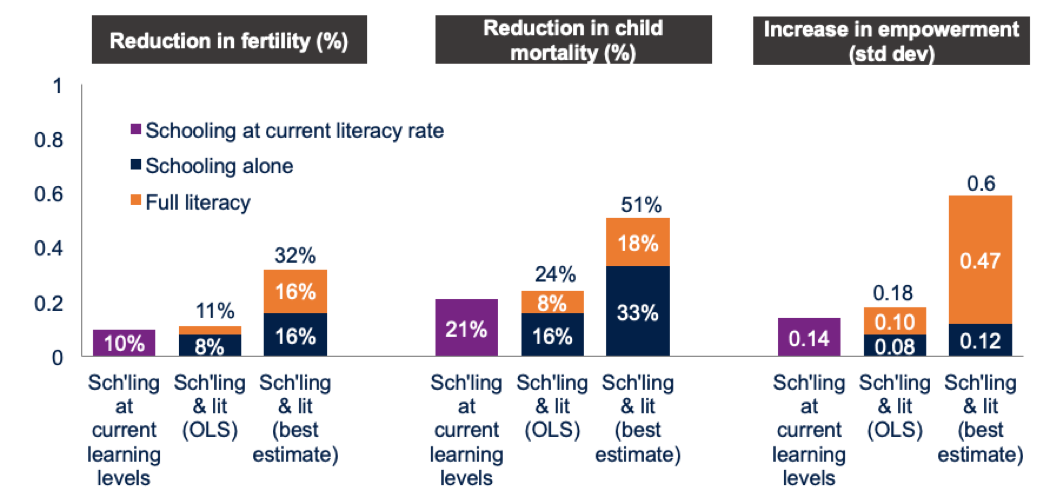
Getting more girls access into poorly performing systems will leave them—at best—with the same poor outcomes as the children already in the system. To deliver quality education to every girl we must both improve systems and raise access.
Take a country like Zambia as an example. In 2015, Zambia participated in the PISA for development (PISA-D). These new data allow us to assess how Zambian girls are doing in terms of progress to the SDG of universal basic literacy, which has been defined as achieving Level 2 on the PISA assessment, and to extrapolate how much increasing access alone could play in achieving universality.
Even among the 37 percent of Zambian girls who were in secondary school at age 15 and hence participated in the PISA-D assessment, only 6.5 percent reached the SDG threshold on literacy. This was already substantially higher than the performance for boys, only 3.5 percent. Since about two thirds of girls were out of school, this meant only 2.5 percent of girls in the country were reaching the literacy SDG. Even if all the out of school girls did manage to stay in school, and even if they achieved the same learning outcomes that their more advantaged peers are now achieving, this would, at best, mean only 6.5 percent of Zambian women would reach age 15 with basic literacy (Figure 2).
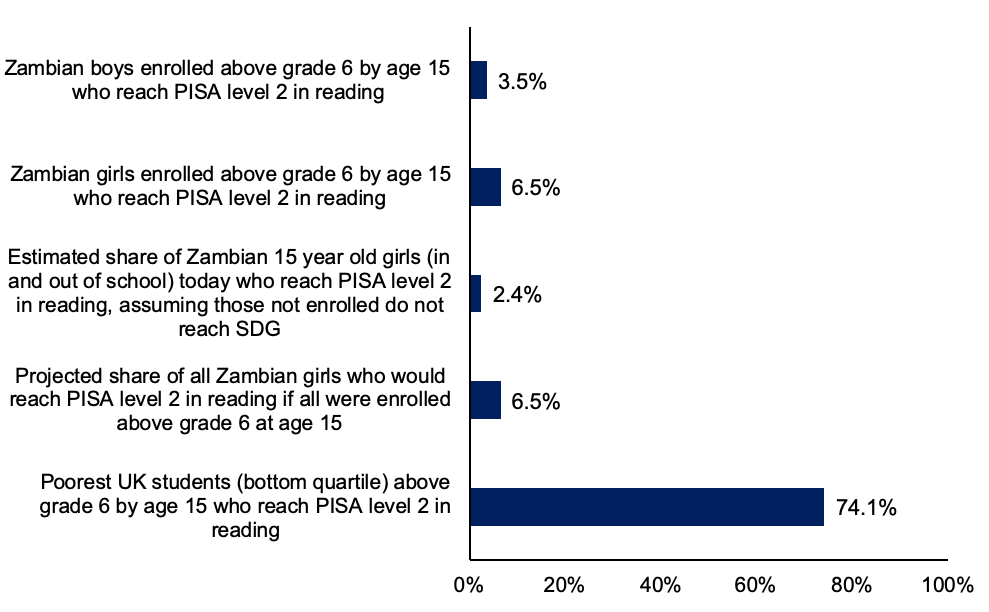
Conducting the same analysis across all the countries that participated in PISA-D shows that only 12.6 percent of girls in the seven countries that participated are reaching the SDG for literacy. As we would expect, projections show that the magnitude of change in the overall women’s literacy rate from ensuring all girls persisted in school through age 15 varies considerably, from as little as 4.1 percent in Zambia, to as much as 19.5 percent in Ecuador. This reflects the variation in overall system performance across these countries. Still, on average, ensuring persistence in school would only result in a 12.3 percentage point increase in the proportion of girls achieving basic reading skills in these seven countries, to 24.9 percent (Figure 3). Even the children from the poorest quartile of families in the UK achieve literacy at four times that rate (74.1 percent, Figure 2).
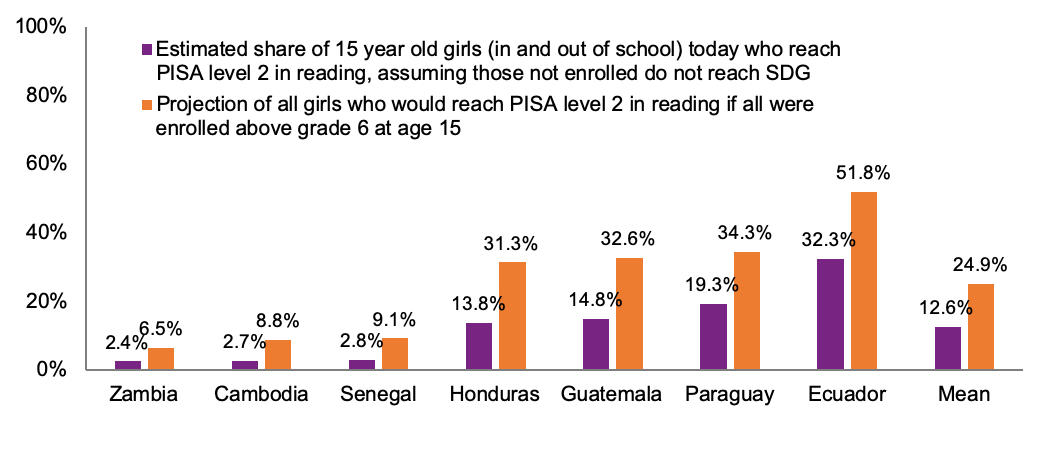
Another way to understand the scope of the problem is to compare the gains to girls’ outcomes that could be realised from bringing them to parity with boys (i.e., to the same levels of schooling and learning) versus to the gains to steepening the overall learning profile for girls, a proxy for improving the overall system. Kaffenberger and Pritchett conduct this analysis in a forthcoming paper in a special issue of the International Journal of Education and Development. They use the Financial Inclusion Insights (FII) data for 10 countries to examine how much gain in literacy there would be from equalizing both schooling attainment and learning profiles across boys and girls versus gains in steepening the overall learning profile for the countries with lagging learning.3
The results (Figure 4) show, again, that the magnitude of the gains vary a lot by country. In Bangladesh, there is already nearly equal schooling and learning across the genders but a very shallow learning profile. Hence the gains from gender equalisation are small but gains from having a steeper learning profile (Indonesia’s, the highest performing of the 10 countries studied) are huge. In other countries, these counter-factual gains are nearly the same magnitude. But, across these 10 countries even full gender parity of schooling attainment and of learning would still leave 30 percent of women illiterate.
This suggests that to realise the full gains of education for every girl, bringing boys and girls into parity in terms of schooling attainment and learning must be accompanied by improvements in overall education systems. The “quality education” component of this agenda is vital, and realising it will require systemic change; in many countries education outcomes are very poor for both girls and boys.
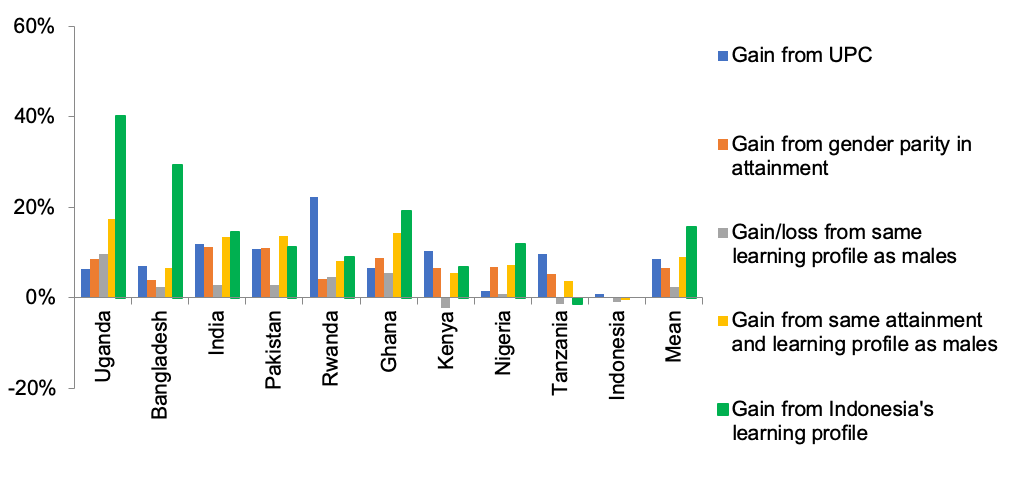
A mounting body of evidence indicates that to deliver learning for all countries should prioritise Universal, Early, Conceptual and Procedural Mastery of Basic Skills (UECPMBS). The importance of starting with the early schooling years is one of the key priorities identified in the 2019 report on “12 Years of Quality Education for All Girls: A Commonwealth Perspective”.4
When children fall behind in the early years they have a very difficult time catching up later in school. This is due in part to the missing foundational skills making it impossible for them to learn more advanced concepts, and in part to curricula that continue to move on to more difficult concepts regardless of mastery levels, leaving many children behind.
We can see this in research from the RISE Indonesia team, which shows that the learning profile for ability to answer simple math problems in Indonesia remains remarkably flat after Grade 6. In the five full grades from 6 to 11 the typical child’s ability to answer basic arithmetic questions improved by only 3 percentage points (Figure 5). As a result, the period between 2000 and 2014 saw the proportion of Indonesians who reached Grade 12 rise by 24%, and yet the proportion of Indonesians who could answer simple, primary school, math questions fell by 0.6%.5
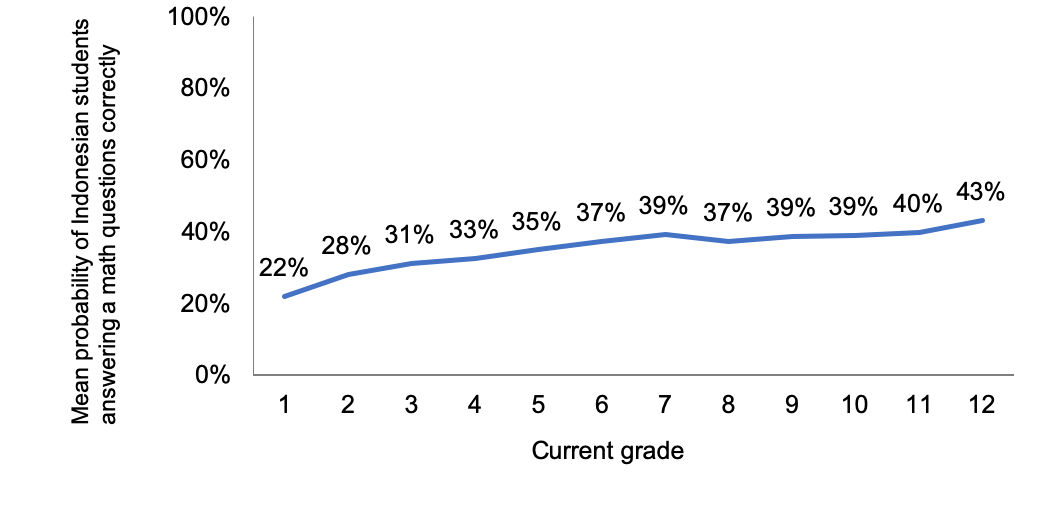
Complementary work from the RISE India team, shows that when children fall behind in the early grades they fail to catch up. Researchers tested students across grade levels on the same assessment. When they plotted the grade level that students were assessed at and compared it to the grade they were in, they found that students who fell behind in early grades struggled to catch up, resulting in a wide variation in abilities within classrooms.6 The average ninth grader had a Grade 4 ability level in mathematics, making it impossible for them to engage with the Grade 9 curriculum and gain further skills.
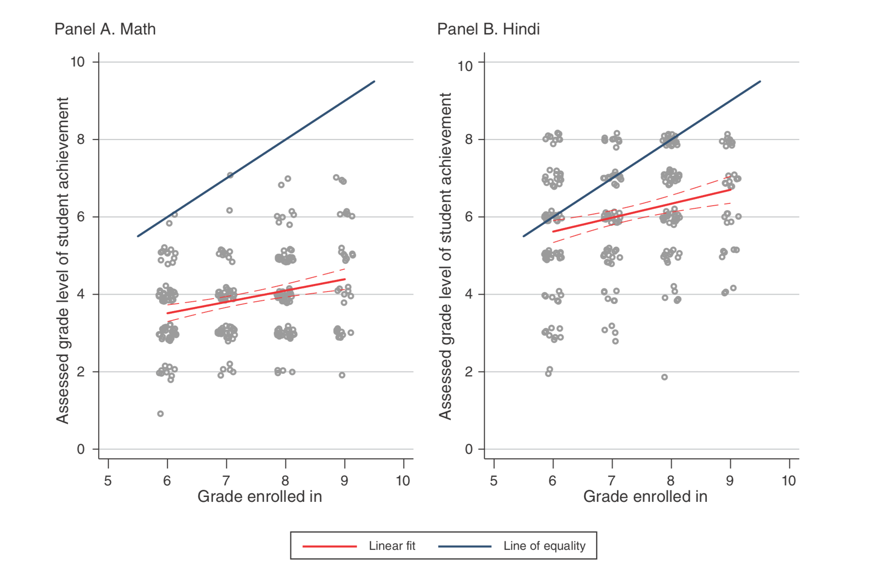
A paper from Kaffenberger and Pritchett uses a model of learning gains to show the importance of intervening early to get the learning profile steep rather than intervening to just extend school grade attainment late.
They model a pedagogical process that can simulate average outcomes among seven developing countries, and which generates a learning profile in which children learn less and less in each grade as the curriculum and instruction leaves them behind. Simulations using the model show that there are more children not learning than there are dropping out. In these simulations achieving universal Grade 10 completion, at current learning trajectories, could produce no additional gains to the SDG of universal literacy, because most of the children who were dropping out before Grade 10 had stopped learning (had fallen behind the curriculum) prior to dropping out.
This suggests that achieving “Grade 12 for every girl”—but not steepening the learning profiles—could have zero impact on the number of girls reaching the SDG learning goals in some contexts. This is because if children drop out when they stop learning because the existing pedagogical and grade/curriculum instructional practices are not benefiting their learning, programs that induce them to stay in school don’t actual change their cumulative learning.7
While they do not argue that these simulation results would always be the case (there is evidence from Pakistan for linear learning profiles), there is some evidence from Indonesia and India, as discussed above, that for the low performing students who do not master skills early, learning gains fall to zero well before children reach Grade 12.
A focus on getting children a conceptual understanding of basic skills in their early primary school years is vital. It is tempting to see children drop out at age 13 or 14 and assume that “intervention” should be focused on those late ages. But many children are dropping out because they did not get good foundations in Grades 1 to 4. Fixing the learning problems there could unlock the potential for more learning later.
If we want to improve outcomes for adolescent girls, we need to start intervening when they are primary school girls. Rushing into targets of “Grade 12 completion” without clear understanding of the learning processes, obstacles to learning, and reasons for drop-out would be ill-advised—as is recognised in the phrase “12 years of quality education.” An effective programme for girls will combine interventions meant to improve outcomes for adolescent girls by intervening both at early ages, and later in their lives when they begin to confront the challenges of adolescence.
A major point that flows from a range of RISE work is that improving girl’s education requires fixing the overall system to be coherent around learning goals. Merely pouring more money into existing systems and approaches will not, in and of itself, produce desirable outcomes. The “thin inputs”, “more budget into the same system”, and “access targets” approaches have dominated the landscape for decades and are why we are where we are on learning (in a crisis).
Relatedly, it seems that gender targeted interventions are likely to be more effective when integrated into an overall coherent reform programme/policy package. Additionally, they will have the greatest effect when a gender specific barrier is a binding constraint on girls education outcomes. RISE work suggests that gender targeted interventions will be more effective as tactics in a strategy to improve the quality of education overall, which is what will be needed to achieve the 12 years of quality education that every girl deserves.
1King, E. M. *Hill. (1993). Women’s education in developing countries: Barriers, benefits, and policies (No. 12171; p. 1). The World Bank. http://documents.worldbank.org/curated/en/849491468740172523/Womens-education-in-developing-countries-barriers- benefits-and-policies
2Kaffenberger et al, “Women’s Education is Even Better than We Thought: Estimating the Gaines from Education when Schooling Ain’t Learning.” Forthcoming.
3Kaffenberger M. and Pritchett P., “Aiming higher: Learning Profiles and Gender Equality in 10 low- and middle-income countries.” (forthcoming) International Journal of Education and Development.
4Gordon, R. Marston, L., Rose, P. and Zubairi, A. 2019. 12 Years of Quality Education for All Girls: A Commonwealth Perspective. REAL Centre. University of Cambridge. https://doi.org/10.5281/zenodo.2542579
5Beatty A. et al. 2018. Indonesia Got Schooled: 15 Years of Rising Enrolment and Flat Learning Profiles. RISE Working Paper Series. 18/026. https//.doi.org/10.35489/BSG-RISE-WP_2018/026
6Muralidharan, K., Singh, A., & Ganimian, A. J. (2019). Disrupting Education? Experimental Evidence on Technology-Aided Instruction in India. American Economic Review, 109(4), 1426–1460. https://doi.org/10.1257/aer.20171112
7Kaffenberger, M. and Pritchett, L. 2020. Failing to Plan? Estimating the Impact of Achieving Schooling Goals on Cohort Learning. RISE Working Paper Series. 20/038. https://doi.org/10.35489/BSG-RISE-WP_2020/038.
Spivack, M. 2020. Quality Education for Every Girl for 12 Years: Insights from RISE Programme Research. RISE Insight Series. 2020/015. https://doi.org/10.35489/BSG-RISE-RI_2020/015